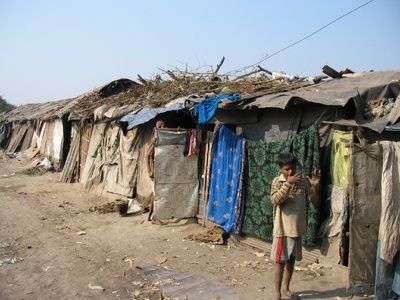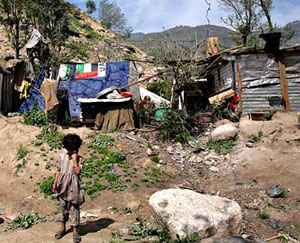The Free Market Experiment in Latin America: Assessing Past Policies and the Search for a Pathway Forward (The second of three parts)

Note: Part I of this three part series set the background regarding neoliberalism in the region. It explored the shortcomings of the free market strategy with respect to economic growth and development, especially by offering comparisons to the previous economic programs of state-led growth. Part II considers the social costs of the neoliberal project and then turns to the factors that have led to widespread abandonment of the experiment with free market economic policies in Latin America.
Social Conditions and Neoliberalism
Poverty in Latin America has been reduced substantially in the last three decades. In the late 1980s, nearly half of Latin America’s population lived in poverty. Today the fraction is about a third. [21] This marks important progress, and it has continued in some area nations. However, it is worth noting that between 2002 and 2008, poverty contracted most in Venezuela, Bolivia, Nicaragua, and Argentina, countries which had largely abandoned neoliberalism; in Brazil, which had at least partially rejected neoliberalism; and in only two other states, Honduras and Perú, which still remained, at least partially, committed to free market polices. [22]
It was mostly factors beyond economic policy that helps to account for recent declines in the rate of Latin American poverty. One factor was increasing remittances from Latin Americans laboring in the developed world, especially in the United States. Total remittances from Latin American workers rose from $12 billion USD in 1995, to $45 billion in 2004, and $68 billion in 2006. [23] However, “by far the main contributor to the reduction in the poverty rate,” as Jaime Ros has noted, was “the fall in the dependency ratio.” [24] The indicator measures the number of non-working age people—children and the elderly—who are supported by the working age population. The higher the dependency number, the greater the economic burden.

Latin America’s past demographic history underlies this shift in the dependency ratio. The late 1940s in Latin America witnessed lower overall death rates (the number of people who died a year divided by the total population), especially due to lower infant and childhood mortality rates. Initially, birth rates stayed high even as death rates fell, but after a generation passed Latin America’s birth rates began to drift downward to match the lower death rates. The time gap between the fall in death rates beginning in the late 1940s and the eventual fall in birth rates by the late 1970s resulted in an unprecedented population explosion. Latin America’s population rose from 167 million in 1950 to 285 million by 1970. As this population cohort has aged, Latin America’s dependency ratio fell too, dropping from a very high rate of 87.3 in the years 1965-1970, to 55.0 for 2005-2010, an all-time low for the region. The people born during the population explosion are of working age now, bringing the region a historic but one-time economic advantage, the “demographic bonus” or “demographic dividend.” As a result, Latin America temporarily enjoys a situation of a very large number of workers providing for a greatly reduced number of dependent people. The region’s demographic bonus means that there is, for the moment, less poverty due, in large part, to the increased number of working age people per household. [25]
A drop in the dependency ratio carries with it greater female participation in the workforce, for lower fertility means there are fewer children to care for, freeing women to enter the paid workforce. Lower fertility also means better overall lifetime health for women, resulting in more years spent in the paid workforce for adult females. The fertility rate (the number of children born per woman per year) fell in Latin America from 5.6 for the years from 1965 to1970, to 2.4 for the years 2005 to 2010. The resulting demographic bonus has provided a significant, but fleeting, economic asset. By 2025, as the current population ages, Latin America will need to support a very large elderly dependent population. [26] It is fair to conclude that the reduction of poverty in Latin America in recent years was produced mainly by some short-term victories in the commodity lottery (as explained in Part I, the commodity lottery refers to short-term price rises for selected raw material exports), as well as a spike in remittances, and most of all, a one-time reduction in the dependency ratio.
Income inequality data for Latin America is less positive. In the 1980s and 1990s, inequality increased significantly in Latin America. For example, from 1984 to 1994, the income of the top 10 percent of the Mexico’s population rose by 21 percent, while the income of the country’s bottom 10 percent fell by 23 percent. Nevertheless, there have been improvements, albeit modest ones, in lowering the Gini coefficient (a measure of economic inequality with 0 being the least inequality—everyone has the same income, and 1.0 being the most inequality—one person has all the income).

From 2002 to 2008, the Gini coefficient improved in seven Latin American states; five of these seven countries—Venezuela, Argentina, Bolivia, Nicaragua, and Paraguay—have traveled the farthest in rejecting neoliberalism. Outside of these nations inequality stayed the same or even increased, including in the largely neoliberal states of Colombia, the Dominican Republic, and Guatemala.
In 1970, the richest 1 percent of Latin Americans earned 363 times more than the poorest 1 percent. By 1995, it was 417 times more. Latin America continues to show, by far, the greatest income inequality of any region in the world. Of the 15 most unequal economies in the world today, 10 are in the area. If Latin America’s income were only as unevenly distributed as that of Eastern Europe or South Asia, its recent economic growth, though sometimes anemic, would have reduced the percentage of those living in poverty to 3 percent of the population. [27]
The Economist, in its 2010 review of the Latin American economic situation, concluded that the region was “well on the way to building middle-class societies.” [28] The evidence, however, contradicts this assertion. The informal sector—where people arrange irregular employment in itinerant retail sales, as day workers, or other loosely arranged jobs—today accounts for more than half of all workers in Latin America. More than eight of ten new jobs in Latin America are in the informal sector. [29] Informal sector workers enjoy no protective regulation or benefits. They live by their wits, striving to scratch out a living, day by day. Meanwhile, union membership among active workers in Latin America fell from around one-fourth in the 1980s to under one-sixth in the 1990s.

Moreover, significant areas of severe poverty remain in Latin America, expressed along class, racial, gender, and regional divides Poverty underlies poor health, contributing to elevated rates of infant, childhood, and maternal mortality. Of those living in poverty in Latin America, nearly half are children. Due to their undernourishment, a quarter of Latin American children (and as many as half in rural Perú and Guatemala) are stunted in their development. Across Latin America malnutrition is an underlying cause in more than half of the deaths of children under the age of five. In Guatemala maternal mortality among indigenous women is 83 percent higher than the national average. Among the poorest fifth of the Perú’s population, 85 percent of births are not attended by trained personnel, compared to only 4 percent among the wealthiest fifth.
Two-thirds of Latin American municipalities do not treat their sewage prior to dumping it into adjacent rivers or the sea. In Panamá, three in ten homes lack access to improved sanitation (sewage disposal), and in Perú, nearly four in ten lack this essential service. Yet with all this effluvium flowing out, still three-quarters of Latin America municipalities do not check public drinking water supplies for impurities. One-quarter of Latin Americans do not have in-home potable water. [30]
In Latin America nearly two-thirds of hospital admissions are due to diseases related to the lack of sanitation. Diarrhea accounts for six of every ten deaths of children under the age of five in Latin America. Fresh water can save lives; for each percentage point increase in potable water coverage, the infant mortality rate drops 1 death per 1,000 live births. Yet, Latin America is falling behind in terms of life expectancy. Life expectancy in Latin America was five years longer than East Asia in the mid-1960s, but by the mid-1990s, it was 1.2 years shorter. [31]
The weight of this evidence leads to an inescapable conclusion. Cambridge economist Ha-Joon Chang has put it most succinctly, “Over the last three decades, economists…provid[ed]…theoretical justifications for financial deregulation and the unrestrained pursuit of short-term profits…[T]hey advanced theories that justified the policies that have led to slower growth…[and] higher inequality…[E]conomics has been worse than irrelevant. Economics, as it has been practiced in the last three decades, has been positively harmful for most people.” [32]
The Twilight of Neoliberalism
“There is no alternative [to free market policies],” the late British Prime Minister Margaret Thatcher once pronounced, but across Latin America, there has been a steady erosion of support for the free market model. At present three-quarters of Latin America governments can be fairly characterized as being governed by center-left or left-oriented leaders. Moreover, there has been a far-reaching reassessment of the relevance of IMF advice, especially after the organization’s punishingly controversial response to the 1997-1998 Asian economic crisis. The Asian economic meltdown brought the reflexive recommendations from the IMF in the form of harsh austerity measures. However, the pro-cyclical policies demanded by the IMF of its client states so plainly worsened the economic situation and needlessly caused considerable human misery that the IMF’s reputation was badly damaged. In the wake of IMF’s subsequent mishandling of the 1998 economic crises in Russia and Brazil, large private lenders, especially among the European ones, stopped requiring IMF assurances that borrowing nations follow neoliberal strictures. As Richard Peet has noted, “the…[IMF]’s reputation has never recovered, even in circles that the Fund values. […] The power of the IMF has been reduced by failed crisis management, [with] countries paying up as quickly as possible and distancing themselves” from the IMF. [33] European lenders concluded that new loans to non-neoliberal Latin American states would perform handsomely, which, in fact, they have. The IMF’s power to impose neoliberal policies on debtor nations has been seriously compromised.

Argentina, following its severe economic crisis in 2001-2002, proved that a nation could successfully challenge the IMF. Argentina defaulted on its $100 billion USD foreign debt and renegotiated its obligations, paying off its loans at a fraction of the original cost. Buenos Aires finished retiring its debt to the IMF in 2005, benefitting greatly from Venezuelan assistance. In offering the money, the late Hugo Chávez promised that, “if additional help is needed to help Argentina finally free itself from the claws of the International Monetary Fund, Argentina can count on us.” [34] Other Latin American nations looked on as Argentina defied the IMF, and continued to watch as Argentina’s economy soared, growing faster than any other nation in the Western Hemisphere after it abandoned IMF-imposed economic policies. Soon a stampede of those flouting IMF mandates followed, with each new defection providing courage to all those nations rejecting neoliberalism.
Other international lenders appeared as well. Venezuela loaned money to other countries in the region, including Bolivia, Ecuador, and Nicaragua, but only if they ignored the counsel of the IMF. The Bank of the South, established in 2007, joined Venezuela with Brazil, Argentina, Ecuador, Bolivia, and Paraguay as an alternative source for credit. China, which does not particularly care what the IMF recommends, is also supplying capital. Furthermore, some primary commodity export prices have increased, in part due to the demand for Chinese imports (for example, Argentine soya). This has allowed several Latin American states to build up their financial reserves, making new foreign borrowing less pressing. Today the IMF can coerce only the most feeble economies, mainly now in sub-Sahara Africa.
The political landscape has shifted too. By the late 1990s, many of the aging left-wing political parties built around organized labor had been flattened by the assault on unions mounted under neoliberalism. At first voters were willing to give candidates who supported the neoliberal program a chance; nevertheless, as it became increasingly clear that these policies were failing, those who spoke out against neoliberalism were elected in growing numbers. The trouble was that once in office they too often carried out neoliberal programs anyway, as for example with Abdalá Bucaram (1996-1997) or Lucio Gutiérrez (2003-2005) in Ecuador, either because they secretly favored such policies, because the IMF persuaded them to do so, or both.
With the traditional left-leaning parties marginalized in several countries and the abandonment of anti-neoliberal promises by elected politicians, ordinary citizens had to develop new political methods to defend themselves. Neoliberal policies so savaged the working class, as well as the urban marginalized and the hard-pressed peasantry, that they had no choice but to organize and fight back. To this end, they created new organizations and, in some cases, used them to seize power. By pressing the neoliberal agenda, the Latin American élites appeared to have overplayed their hand, and they paid for it by losing control of governments that they had controlled for many years, in Venezuela, Ecuador, Bolivia, and beyond. A 2009 Latinobarómetro Survey found that support for democracy (as preferable to all other forms of government) was the strongest in countries that flatly rejected neoliberalism. Of the top five nations in popular support of democracy, four were governed by progressive leaders: Venezuela, Bolivia, Uruguay, and El Salvador. [35]
Hope for the Future?
Supporters of the free market approach have continued to counsel patience. They argue that stronger economic growth will eventually come, and that all will benefit in the long run. While neoliberal reforms might cause some short-term belt tightening, defenders explain that such adjustments, though sometimes painful, are necessary for the greatest good. We should not give in to “reform fatigue,” but should stay the course. [36] But neoliberal policies have been in place for over 30 years now. How long is the long run? How long must we wait? As John Maynard Keynes famously observed, “In the long run we are all dead.” In 1937 U.S. President Franklin D. Roosevelt observed, “We have always known that heedless self-interest was bad morals. We know now that it is bad economics.” [37] The age of neoliberalism is ending. It is time for some good economics.
Dr. Ronn Pineo, Senior Research Fellow at the Council on Hemispheric Affairs, and Professor and Chair of the Department of History at Towson University
Author’s Note: Part III will explore the search for new developmental policies.
Please accept this article as a free contribution from COHA, but if re-posting, please afford authorial and institutional attribution. Exclusive rights can be negotiated.
For additional news or analysis on Latin America, please go to: Latin News
_____________________________
References
(Continued from Part I)
[21] Bárenca, “Structural Constraints,” 10-11; and Ocampo, “Latin America’s Growth,” 81-82.
[22] Montecino, Juan A. “Decreasing Inequality Under Latin America’s ‘Social Democratic’ and ‘Populist’ Governments: Is the Difference Real?” Center for Economic and Policy Research (October 2011), 1; Bárenca, “Structural Constraints,” 12; and Puryear, Jeffrey and Molloy Jewers, Mariellen. “How Poor and Unequal is Latin America and the Caribbean?” Social Policy (November 2009). For a contrary view, see McLeod, Darryl and Lustig, Nora. “Inequality and Poverty Under Latin America’s New Left Regimes.” Tulane Economics Working Paper 1117 (March 2011): 1-31.
[23] Weintraub, “Economic Storm, 59.
[24] Ros, “Poverty Reduction,” 42.
[25] United Nations. ECLAC. Latin American 2012, 7; Bárenca, “Structural Constraints,” 23; and Ros, “Poverty Reduction,” 39-40, 42-43.
[26] Leeson, George W. “Prepared or Not, Latin America Faces the Challenge of Aging,” Current History (February 2011): 76-77; Hausmann, “Structural Transformation,” 520; Moreno-Brid and Ros, Development and Growth, 216; Helwege, Ann and Birch, Melissa B.L. “Declining Poverty In Latin America? A Critical Analysis of New Estimates by International Institutions,” Global Development and Environmental Institute Working Paper No. 07-02 (September 2007), 3; and Ross, John. “Understanding the Demographic Dividend,” POLICY Project (September 2004), 3.
[27] ECLAC. Economic Outlook 2012, 9; Gasparini, Leonardo and Lustig, Nora. “The Rise and Fall of Income Inequality in Latin America,” in Oxford Handbook, 691-692, 696; Santiso and Zoido, “Fiscal Legitimacy,” 295; Bárenca, “Structural Constraints,” 12; Zibechi, Raúl. “The Rising Power of Slum Democracy,” New Internationalist 436 (October 2010), 28; Lustig, Nora. “Poverty, Inequality, and the ‘New Left’ in Latin America,” Woodrow Wilson International Center for Scholars, July 21, 2009; Ros, “Poverty Reduction,” 38; Helwege and Birch, “Declining Poverty,” 24; Pribble, Jennifer, et al. “The Politics of Poverty in Latin America and the Caribbean,” Meetings of the American Political Science Association, Washington, DC, September 1-4, 2005, 6-7; and Hoffman, Kelly and Centeno, Miguel Angel. “The Lopsided Continent: Inequality in Latin America.” Annual Review of Sociology 29 (2003): 368.
[28] “Societies on the Move.” The Economist 396 (September 11, 2010): 8699.
[29] Ocampo, “Latin America’s Growth,” 26.
[30] ECLAC. Latin America 2012, 12; Gasparini and Lustig, “Income Inequality,” 717;
Montenegro, A. and Stephens, Carolyn. “Indigenous Health 2: Indigenous Health in Latin America and the Caribbean,” The Lancet 367 (June 3, 2006): 1859-1869; United Nations. The Millennium Development Goals: A Latin American and Caribbean Perspective. United Nations, 2005, 68, 73, 139, 141, 144, 148-150, 163; Replogle, Jill. “Hunger on the Rise in Central America.” The Lancet 363 (June 19, 2004): 2056-2057; Pan American Health Organization. Health in the Americas. Volumes I and II. PAHO, 2002; Casas, Juan Antonio, et al. “Health Disparities in Latin America and the Caribbean: The Role of Social and Economic Determinants,” in PAHO. Equity & Health: Views from the Pan American Sanitary Bureau. PAHO, 2001; and Londoño, Juan Luis and Székely, Miguel. “Persistent Poverty and Excess Inequality: Latin America, 1970-1995.” Journal of Applied Economics 3:1 (May 2000): 93-134.
[31] Boscov-Ellen, Lisa. “Thirst for Profit: Corporate Control of Water, in Latin America.” Council on Hemispheric Affairs, June 19, 2009; and Powdar, Ashely. “One of History’s Great Atrocities: The Corporate Theft of the Public’s Natural Right to Water.” Council on Hemispheric Affairs, April 20, 2008.
[32] Chang. 23 Things, 247-248.
[33] Peet, Richard. Unholy Trinity: The IMF, World Bank and WTO. Zed Books, 2009, 93, 125.
[34] Weisbrot, Mark. “Latin America: The End of an Era.” Center for Economic Policy Research. (Winter 2006).
[35] “A Slow Maturing of Democracy: More Latin Americans Now Trust the Government than the Army.” The Economist (December 10, 2009).
[36] Stallings, Barbara and Peres, Wilson. “Is Economic Reform Dead in Latin America? Rhetoric and Reality Since 2000.” Journal of Latin American Studies 43 (2011): 757; Birdsall, Nancy, et al. “The Washington Consensus: Assessing, a ‘Damaged Brand.’” The Oxford Handbook of Latin American Economics. Oxford University Press, 2011, 90.
[37] Roosevelt, Franklin. Second Inaugural Address. (January 20, 1937).

